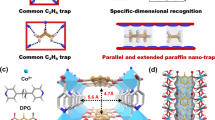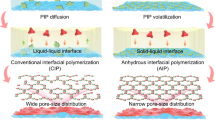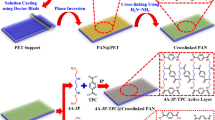Abstract
PEBAX-5513/AgBF4/Al(NO3)3 membranes were fabricated for mixed olefin/paraffin separation. In order to improve the selectivity of the membranes utilizing PEBAX-1657, PEBAX-5513, which increased the ratio of amide groups from 40% to 60% in the copolymer, was used. The selectivity and permeance of the membranes were 7.7 and 11.1 GPU, respectively. Furthermore, the PEBAX–5513/AgBF4/Al(NO3)3 membranes had long-term stability because of Al(NO3) to have the stabilizing effect on Ag+ ions acting as an olefin carrier. Unexpectedly, the performance of the membrane selectivity was not improved, and the permeance became rather lower. Generally, when Ag+ ions was added to the polymer containing amide groups, the selectivity increased with the content of the amide groups. However, Al(NO3)3 was added for the stability of Ag+ ions and there was no increase in selectivity. Since the ratio of amide was high, Ag+ ions were favorably in coordination with the oxygen of the carbonyl group, but the NO3− ions in Al(NO3)3 had the enhanced interaction with Ag+ ions as obstacles for olefin complexation. Therefore, the composition ratio of amide/ether in the polymer matrix was negligible for olefin separation.
Similar content being viewed by others
Introduction
Recently, the separation of propylene/propane mixtures has become important in industrial processes1. Olefins and paraffins have similar chemical characteristics; therefore, the fuel efficiency has been found to be very low when fuel is used without separating them2. Hence, the techniques of their separation have been in the spotlight3. However, conventional separation methods showed problems such as high cost and low efficiency4; hence, recently, separation methods using membranes have attracted much attention5. Especially, polymeric membranes made it possible for energy, process cost and process to be efficient6,7,8.
The facilitated transport of polymer membranes using Ag+ ions from precursors such as AgBF4, AgCF3SO3, and AgNO3 showed prominent achievement for olefin/paraffin separation9,10,11,12. It was proved that the permeance and selectivity of the membrane increased upon the addition of the Ag salts. Furthermore, many polymers such as poly(2-ethyl-2-oxazoline) (POZ), polyvinylpyrrolidone (PVP)13, and poly(vinyl alcohol) (PVA)14 were used as the matrices of the membrane to improve the membrane properties.
However, Ag+ ions were easily reduced over time to form particles, and these particles have the disadvantage of interfering with the permeation of gases. Our group reported a membrane with Al(NO3)3 added to delay the reduction of the Ag+ ions, and to maintain the long-term durability of the membrane15. The membrane properties of the POZ/AgBF4/Al(NO3)3 membrane lasted for more than 14 days, and the white color of the membranes remained unchanged for 3 months due to the reduction of Ag+ ions15. These phenomena were generated from that the Al3+ ions in Al(NO3)3 had a favorable electrostatic interaction with the BF4− ions in AgBF4. Thus, the interaction between BF4− ions and its counter ion, Ag+ ions, was relatively weaker and the Ag+ ions as an olefin carrier was freed without reduction16. As a result, the POZ/AgBF4/Al(NO3)3 membrane had long-term stability. However, unfortunately, it had a relatively low permeance of 4.8 GPU15.
To improve the permeance, we used a highly permeable polymer, PEBAX-1657, as the membrane matrix, in an earlier study6. Using the complex with PEBAX-1657 as the matrix, we achieved an enhanced performance of 22.5 GPU with 8.8 selectivity6.
Poly(ether-block-amide) resin, a typical thermoplastic elastomer, was widely known as PEBAX. PEBAX was consisted of a linear chain combination of polyamide, a hard segment responsible for mechanical strength, and polyehter, a soft segment responsible for high permeability due to high chain mobility of the ether linkage17.
In case of PEBAX-1657, 60% of the permeable ether group and 40% of the hard amide group were able to obtain a high permeance, but the selectivity tended to be relatively low6.
In this study, to increase the selectivity, PEBAX-5513, which increased the ratio of the amide groups capable of showing high selectivity, was selected as the polymer matrix.
Results and Discussion
SEM images analysis
SEM images were obtained to confirm that the selective layer was uniformly distributed. Figure 1 shows the cross-section of the selective layer of PEBAX-5513/AgBF4/Al(NO3)3 coated on the porous polysulfone. The image shows that the selective layer of PEBAX-5513/AgBF4/Al(NO3)3 was uniformly coated and the thickness was 3.2 µm.
Separation performance
Figure 2 shows the permeance and selectivity of the PEBAX-5513/AgBF4/Al(NO3)3 membrane for a propylene/propane mixture. The permeance and selectivity of the membrane were about 11.1 GPU and 7.7, respectively. Furthermore, Ag+ ions could act as olefin carriers, owing to Al(NO3)3, a reduction inhibitor. Thus, the long-term stability of the membrane was confirmed over 100 h. In another earlier study, a high selectivity was observed due to the coordination of the carbonyl oxygens of the amide group with the Ag+ ions18,19,20,21,22. However, similar results were not observed in this study. The reason for these phenomena is discussed in the next section.
FT-IR analysis
Figure 3 shows the FT-IR spectrum of the neat PEBAX-5513, PEBAX-5513/AgBF4, and PEBAX-5513/AgBF4/Al(NO3)3. For the neat PEBAX-5513 spectrum, the peak of C=O bond was observed at 1635 cm−1, but the peak moved to 1612 cm−1 when AgBF4 was added. This was because the intensity of the C=O bond peak was weakened as the Ag+ ions of AgBF4 react with the oxygen atom of the C=O bond in the amide group of the polymer. Thereafter, when Al(NO3)3 was added to PEBAX-5513/AgBF4, the peak of C=O bond shifted to 1623 cm−1. This was due to the NO3− ions interacting with the Ag+ ions bound to the oxygen atom of the C=O. Thus, the intensity of the C=O bond peak was restored, and the C=O bond peak shifted to a higher. For PEBAX-1657, when AgBF4 was added, the wavenumber of the C=O bond peak slightly decreased from 1637 to 1620 cm−1 6; however, for PEBAX-5513, it decreased significantly from 1635 to 1612 cm−1. This was because PEBAX-5513 had a higher proportion of amide groups than that of PEBAX-1657, since Ag+ more favorably coordinates to the amide group than the ether group. However, when Al(NO3)3 was added, the recovered wavenumber of the C=O bond peak was similar for both PEBAX-5513 and PEBAX-1657. Hence, it was thought that the degree of coordination of the NO3− ions of Al(NO3)3 with Ag+ ions was similar.
TGA analysis
To investigate the thermal stability of neat PEBAX-5513, PEBAX-5513/AgBF4, and PEBAX-5513/AgBF4/Al(NO3)3, TGA analysis was performed from 0 to 600 °C as shown in Fig. 4. In PEBAX-5513/AgBF4, although the Ag+ ions formed a bridge between the polymer chains, the Ag+ ions coordinated to the amide group weakened the existing intermolecular attractions in the polymer. The enhanced free volume of the polymer caused plasticization. As a result, the thermal stability seemed to decrease. However, when Al(NO3)3 was added, the results were different from those for PEBAX-1657. The thermal stability of PEBAX-1657 slightly increased6, since the NO3− ions of Al(NO3)3 formed a new bond with the Ag+ ions coordinated to the C=O bond, weakening the bonds between oxygen and Ag+ ions. On the contrary, when Al(NO3)3 was added to PEBAX-5513/AgBF4, even the crosslinking formed between the Ag+ ions and polymer chain collapsed, and the thermal stability was expected to be lower.
Raman analysis
Figures 5 and 6 showed the Raman graph used to confirm the state of the BF4− and NO3− ions. Figure 5 indicated the state of BF4− ions, which meant free ions, ion pairs, and ion aggregates at 765, 770, and 774 cm−1, respectively. In the case of PEBAX-1657/AgBF4, BF4− ions exist mainly in the form of free ions, but also in the form of ion pairs and ion aggregates6. On the other hand, in PEBAX-5513/AgBF4, it was observed that BF4− ions exists only as a free ion. This was due to the abundant amide groups in PEBAX-5513; therefore, the Ag+ ion could be strongly coordinated, being free of BF4−. In the case of PEBAX-1657/AgBF4/Al(NO3)3, the interaction between the Al3+ ions and BF4− ions were generated. Then, BF4− ions became the ion pairs state with Al3+ ions6. However, in PEBAX-5513/AgBF4/Al(NO3)3, the Al3+ ions was bound to the abundant amide; hence, BF4− ions was expected to be able to maintain a free state. Figure 6 showed the state of the NO3− ions, which indicated free ions, ion pairs, and ion aggregates, corresponding to 1034, 1040, and 1045 cm−1, respectively23. In PEBAX-5513/AgBF4/Al(NO3)3, the NO3− ions react with Ag+ ions to form ion aggregates, corresponding to 1046 cm−1.
Conclusions
The polymer matrix of PEBAX-1657/AgBF4/Al(NO3)3 used in an earlier study was changed to PEBAX-5513, with a higher amide group ratio in PEBAX, to improve the selectivity as shown in Fig. 7. The membrane permeance decreased because the proportion of the ether group, the permeable segment in PEBAX, decreased. However, there was no increase in selectivity. Since the ratio of amide was high, Ag+ ions were favorably in coordination with the oxygen of the carbonyl group, but the NO3− ions had the enhanced interaction with Ag+ ions as obstacles for olefin complexation. As a result, the effect of the ratio of amide/ether in the polymer matrix could be negligible for Ag+ ions to act as olefin carriers for polymer/Ag salt/Al(NO3)3 complex membranes. Therefore, these results should be considered for the future design of block-copolymer syntheses to obtain high-selectivity/high-permeability membranes.
Methods
Materials
Poly(ether-block-amide)–5513 (PEBAX-5513) was manufactured by Arkema Inc. Silver tetrafluoroborate (AgBF4; 98%) was purchased from TCI Fine Chemicals. Aluminum nitrate nonahydrate (Al(NO3)3·9H2O; 98%) was purchased from Aldrich Co. All the chemicals were used as received.
Preparation of membranes
PEBAX-5513 was dissolved in a mixed solvent of distilled water and ethanol at 90 °C to prepare a solution having a concentration of 3 wt%. The solution was allowed to cool at room temperature, and then AgBF4 was added as an olefin carrier so as to have a concentration of 17 wt% of the total solution. Al(NO3)3 was added as a reduction inhibitor of Ag+ ions so as to have a 0.1 mol ratio with respect to AgBF4. The solution was then stirred for 1 hour at room temperature and coated on the polysulfone support (Toray chemical, Inc., Korea) using an RK Control Coater (Model 202, Control Coater RK Print-Coat Instruments Ltd., UK). The solution-coated complex was dried in vacuum oven for 24 hours at room temperature.
Gas separation experiments
The performance of PEBAX-5513/AgBF4/Al(NO3)3 membranes was tested using a propane/propylene mixed gas(50:50 vol%). The permeance of the membranes was obtained using a bubble flow meter and the selectivity was obtained using gas chromatography(GC). The flow of the mixed gas was controlled by a mass flow controller (MFC), and the gas permeance was expressed as GPU (1 GPU is 1 × 10−6 cm3 (STP)/(cm2 s cmHg)).
Characterization
The prepared membranes were characterized by scanning electron microscopy (SEM; JSM-5600LV, JEOL). A VERTEX 70 FT-IR spectrometer (Bruker Optics Inc.) was used to investigate the chemical change in the membranes. The thermal stability of the membranes was measured by thermogravimetric analysis (TGA; Universal V4.5 A, TA Instruments). Raman spectra of the PEBAX-5513/AgBF4/Al(NO3)3 complex membrane were collected at room temperature using a Bruker Optics Ram II Raman module with a resolution of 4 cm−1.
References
Hamid, M. R. A. & Jeong, H.-K. Recent advances on mixed-matrix membranes for gas separation: Opportunities and engineering challenges. Korean J. Chem. Eng. 35(8), 1577–1600 (2018).
Kwon, H. T., Jeong, H.-K., Lee, A. S., An, H. S. & Lee, J. S. Heteroepitaxially Grown Zeolitic Imidazolate Framework Membranes with Unprecedented Propylene/Propane Separation Performances. J. Am. Chem. Soc. 137, 12304–12311 (2015).
Böhme, U. et al. Ethene/Ethane and Propene/Propane Separation via the Olefin and Paraffin Selective Metal–Organic Framework Adsorbents CPO-27 and ZIF-8. J. Am. Chem. Soc. 29, 8592–8600 (2013).
Jiao, Z. et al. Improved performance of polyamide nanofiltration membranes by incorporating reduced glutathione during interfacial polymerization. Korean J. Chem. Eng. 35(12), 2487–2495 (2018).
Afsarian, Z. & Mansourpanah, Y. Surface and pore modification of tripolyphosphate-crosslinked chitosan/polyethersulfone composite nanofiltration membrane; characterization and performance evaluation. Korean J. Chem. Eng. 35(9), 1867–1877 (2018).
Jeong, S., Sohn, H. & Kang, S. W. Highly permeable PEBAX-1657 membranes to have long-term stability for facilitated olefin transport. Chem. Eng. J. 333, 276–279 (2018).
Kim, S. H. & Hong, S. R. Gas Permeation Characteristics by Chitosan/Pebax Composite Membranes. Membr. J. 27, 319–327 (2017).
Park, J. H. et al. Anion-exchange-membrane-based electrochemical synthesis of ammonia as a carrier of hydrogen energy. Korean J. Chem. Eng. 35(8), 1620–1625 (2018).
Kim, J. H., Park, S. M., Won, J. & Kang, Y. S. Unusual separation property of propylene/propane mixtures through polymer/silver complex membranes containing mixed salts. J. Membr. Sci. 248, 171–176 (2005).
Lee, D. H., Kang, Y. S. & Kim, H. J. Olefin separation performances and coordination behaviors of facilitated transport membranes based on poly(styrene-b-isoprene-b-styrene)/silver salt complexes. Macromolecules 17, 104–109 (2009).
Kim, J. K. et al. Novel composite membranes comprising silver salts physically dispersed in poly(ethylene-co-propylene) for the separation of propylene/propane. Macromolecules 15, 343–347 (2007).
Joo, S. H., Kim, J. H., Kang, S. W., Jang, J. & Kang, Y. S. Propylene sorption and coordinative interactions for poly(N‐vinyl pyrrolidone‐co‐vinyl acetate)/silver salt complex membranes.J.Poly. Sci. Part B: Poly. Phy. 45, 2263–2269 (2007).
Hong, S. U., Jin, J. H., Won, J. & Kang, Y. S. Polymer–Salt Complexes Containing Silver Ions and Their Application to Facilitated Olefin Transport Membranes. Adv. Mater. 12, 968–971 (2000).
Kim, J. H., Min, B. R., Lee, K. B., Won, J. & Kang, Y. S. Coordination structure of various ligands in crosslinked PVA to silver ions for facilitated olefin transport. Chem. Commun. 22, 2732–2733 (2002).
Kang, S. W., Kim, J. H., Won, J. & Kang, Y. S. Suppression of silver ion reduction by Al(NO3)3 complex and its application to highly stabilized olefin transport membranes. J. Membr. Sci. 445, 156–159 (2013).
Song, D., Kang, Y. S. & Kang, S. W. Highly permeable and stabilized olefin transport membranes based on a poly(ethylene oxide) matrix and Al(NO3)3. J. Membr. Sci. 474, 273–276 (2015).
PEBAX-Basis of Performance, Polyether Block Amide, Elf Atochem Technical Document, Paris, France.
Kang, S. W., Kim, J. H., Char, K., Won, J. & Kang, Y. S. Nanocomposite silver polymer electrolytes as facilitated olefin transport membranes. J. Membr. Sci. 285, 102–107 (2006).
Faiz, R. & Li, K. Olefin/paraffin separation using membrane based facilitated transport/chemical absorption techniques. Chem. Eng. Sci. 73, 261–284 (2012).
Merkel, T. C. et al. Silver salt facilitated transport membranes for olefin/paraffin separations: Carrier instability and a novel regeneration method. J. Membr. Sci. 447, 177–189 (2013).
Park, Y. S., Kang, Y. S. & Kang, S. W. Cost-effective facilitated olefin transport membranes consisting of polymer/AgCF3SO3/Al(NO3)(3) with long-term stability. J. Membr. Sci. 495, 61–64 (2015).
Kang, S. W., Kim, J. H., Won, J., Char, K. & Kang, Y. S. Effect of amino acids in polymer/silver salt complex membranes on facilitated olefin transport. J. Membr. Sci. 248, 201–206 (2005).
Kim, J. H., Min, B. R., Kim, C. K., Won, J. & Kang, Y. S. Spectroscopic interpretation of silver ion complexation with propylene in silver polymer electrolytes. J. Phys. Chem. 106, 2786–2790 (2002).
Acknowledgements
This work was supported by the Basic Science Research Program (2017R1D1A1B03032583) through the National Research Foundation of Korea (NRF), funded by the Ministry of Science, ICT, and Future Planning. This study was also funded by Korea Environment Industry & Technology Institute (KEITI) as “Technology Program for establishing biocide safety management”. (RE201805019).
Author information
Authors and Affiliations
Contributions
S.W.K. led the project, conducted the data analysis and reviewed the manuscript. K.W.J. performed the experiments, collected the data and wrote the paper.
Corresponding author
Ethics declarations
Competing Interests
The authors declare no competing interests.
Additional information
Publisher’s note: Springer Nature remains neutral with regard to jurisdictional claims in published maps and institutional affiliations.
Rights and permissions
Open Access This article is licensed under a Creative Commons Attribution 4.0 International License, which permits use, sharing, adaptation, distribution and reproduction in any medium or format, as long as you give appropriate credit to the original author(s) and the source, provide a link to the Creative Commons license, and indicate if changes were made. The images or other third party material in this article are included in the article’s Creative Commons license, unless indicated otherwise in a credit line to the material. If material is not included in the article’s Creative Commons license and your intended use is not permitted by statutory regulation or exceeds the permitted use, you will need to obtain permission directly from the copyright holder. To view a copy of this license, visit http://creativecommons.org/licenses/by/4.0/.
About this article
Cite this article
Jung, K., Kang, S.W. Effect of functional group ratio in PEBAX copolymer on propylene/propane separation for facilitated olefin transport membranes. Sci Rep 9, 11454 (2019). https://doi.org/10.1038/s41598-019-47996-7
Received:
Accepted:
Published:
DOI: https://doi.org/10.1038/s41598-019-47996-7
This article is cited by
-
Mixed matrix composite membranes based on amination of reduced graphene oxide for CO2 separation: Effects of heating time and nanofiller loading
Korean Journal of Chemical Engineering (2020)
Comments
By submitting a comment you agree to abide by our Terms and Community Guidelines. If you find something abusive or that does not comply with our terms or guidelines please flag it as inappropriate.










